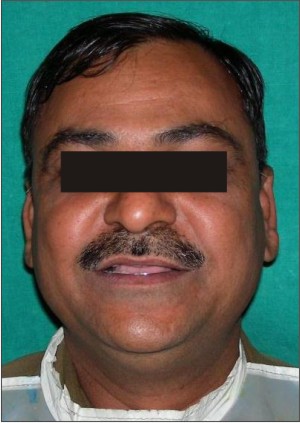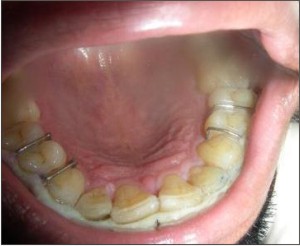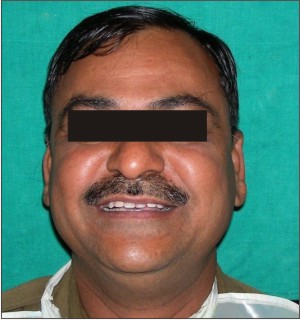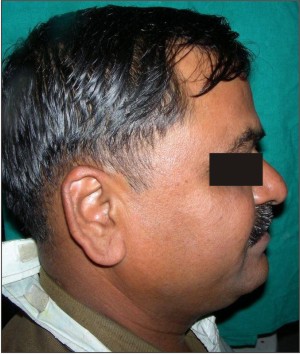|
|
|
| Cosmetic Overdenture - A Case Report |
Sandhu Rupinder 1 , Gupta Ashok K 2 , Chandra Gaurav 3 , Narayan Jayprakash 4
1 Assistant Professor , Dept of Prosthodontics, - Institute Of Dental Education And Advanced Studies, Hospital & Research Centre, Gwalior, MP, India
2 Assistant Professor, Dept of Oral & Maxillofacial Surgery, - Institute Of Dental Education And Advanced Studies, Hospital & Research Centre, Gwalior, MP, India
3 Senior Lecturer, Department of Prosthodontics - Chandra Dental College & Hospital, Lucknow, UP.
4 Senior Lecturer, Dept of Prosthodontics, - Institute Of Dental Education And Advanced Studies, Hospital & Research Centre, Gwalior, MP, India
|
| Address For Correspondence |
Dr. Rupinder Sandhu , C/O Dr. Ashok Gupta,
Sanjeevani Multispeciality Dental Clinic,
111, Saugat Appartments, Near Millenium Plaza,
University Road, Govindpuri, Gwalior.
Mobile no. +919301922853,
E-mail sandhuuz@yahoo.com, guptaaaz@gmail.com |
| Abstract |
| A challenge facing prosthodontists is the achievement of an optimum esthetic smile adopting conventional or unconventional techniques. Rehabilitation of a patient facing poor esthetics with intact and normally functional dentition is an interesting challenge. This article presents a situation where a patient with improper profile due to posteriorly placed maxilla and reverse horizontal overlap of anterior teeth was rehabilitated prosthodontically with cosmetic overdenture. |
|
| Keywords |
| Cosmetic overdenture, facial esthetics |
|
| Full Text |
Introduction
Facial esthetics has been found to be a significant determinant of self and social perception of the individual. Anterior position of the maxillary frontal teeth has a strong influence on patient's esthetics. The challenge facing prosthodontists is the achievement of an optimum esthetics in certain difficult situations. Removable or fixed partial denture along with gingival extensions[1] or gingival prosthesis[2] have been used to replace the missing or augment the deficient tissue to improve esthetics. Most difficult task is the augmentation of tooth position and their corresponding gingivae in matured patients with intact and normally functional dentition.
Case Report
A 35 year old man reported to department of orthodontics & dentofacial orthopedic for esthetic inadequacy of his permanent teeth. During conversation it was observed that he had depressed upper lip and maxillary anterior teeth were not visible at all while speaking or smiling (Fig.1, Fig.2). Moreover, he appeared partially edentulous in the maxillary anterior region although the entire dentition was intact. The patient expressed extreme dissatisfaction with his appearance.
Further examination revealed posteriorly placed maxilla and maxillary anterior teeth were in reverse horizontal overlap with mandibular anterior teeth (Fig.3). Diagnostic casts were made and consultations were done with maxillofacial surgery department. Treatment objective was to improve
 | Figure 1: Patient appearing edentulous while smiling.
 |
 | Figure 2: Lateral view showing depressed upper lip.
 |
facial esthetics. Patient was informed about the treatment options of orthognathic surgery and orthodontic treatment. The patient was also explained about the treatment cost, time period to conclude the treatment, possible esthetic results and complications if any, of the various treatment options. Patient didn't want any surgical or orthodontic treatment for want of time, being a police officer. Patient was referred to department of prosthodontics for any possible treatment modality. Patient was examined and a prosthetic approach in the form of cosmetic overdenture was discussed. Although the patient was not very convinced about the treatment at the initial stage but agreed for treatment involving 2 to 3 visits.
After oral prophylaxis, irreversible hydrocolloid impressions (Neocolloid; Zhermack Spa, Germany) were made for both maxillary and mandibular arch and casts obtained in type III dental stone (Kalstone; Kalabhai, Mumbai, India). A thin transparent plastic sheet of 1mm was adapted to the maxillary cast using vaccum former for facilitating the try in procedure. Thin layer of modelling wax(Y-dent; Mdm corporation, Delhi, India), was applied over the sheet towards labial surface to position the teeth. Acrylic denture teeth (Premadent; Super dental products, Delhi, India) were selected and trimmed from the palatal aspect. Both maxillary and mandibular casts were mounted and teeth were arranged over the wax in most desirable position and checked in patient's mouth for the amount of lip support, visibility of maxillary anterior teeth and facial profile (Fig.4). Thickness of the wax was adjusted to position the teeth for a pleasing appearance without interfering with the occlusal function and speech.
Patient's approval of esthetics and phonetics was taken. To overcome the problem of retention in the definitive prosthesis interproximal clasps, two on each side were fabricated in canine and premolar region. After try-in-procedure acrylization was done in conventional manner using heat polymerizing tooth colored acrylic resin (Ashvin; Super dental products, Delhi, India). Resin from the gingival part was trimmed with carbide bur and replaced with pink colored auto polymerizing acrylic resin (Ashvin; Super dental products, Delhi, India). Finishing and polishing were done (Fig.5). The prosthesis was checked in patient's mouth and required adjustments were done (Fig.6).
There was significant improvement in esthetics in relation to profile, lip support and visibility of teeth (Fig.7, Fig.8). Patient was satisfied more than the initial expectations. Instructions for care of prosthesis were given to achieve a favorable long term prognosis. Patient was checked after 2 weeks and 4 weeks and no complication was observed.
Discussion
Maxillary anterior teeth play an important part in esthetically pleasing smile. Anatomically correct contour and position of teeth are critical factors for pleasing appearance. Different treatment options exist to achieve this goal in retropositioned maxilla and maxillary anterior teeth. This problem gets worsened when the teeth are in reverse horizontal overlap. The maxillary anterior teeth do not provide support to the lip & lip droops down coming
 | Figure 3: Reverse horizontal overlap of anterior teeth.
 |
 | Figure 4: Try in done with arrangement of trimmed acrylic teeth over modelling wax
 |
 | Figure 5: Definitive prosthesis after finishing and polishing.
 |
 | Figure 6: Definitive prosthesis in place.
 |
 | Figure 7: Frontal view showing change in visibility of maxillary anterior teeth.
 |
 | Figure 8: Lateral view showing change in upper lip support.
 |
to a level lower than their incisal surface. Patient appears edentulous. Although surgical procedures (Orthognathic Surgery) give permanent results, but the surgical cost, healing time, discomfort and unpredictability make this choice unpopular. Orthodontic treatment takes long time to deliver results. The choice of treatment is dependent upon the individual circumstances, perceived needs and concerns of the patient and in the present case patient placed considerable importance on the appearance of his anterior teeth.
The scanning of the prosthodontics literature does not reveal similar kind of situation. However, there is a reporting about the use of cosmetic overdenture in a professional model for correction of deviated midline, missing lateral incisor, and diastema[3].Gingival prostheses along with a fixed or removable partial denture[1] and veneers for maxillary anterior teeth[4] have also been used to improve esthetics. The cosmetic overdenture is a prosthesis used to improve the appearance of an individual for esthetic purposes without altering an otherwise functional dentition[3]. A cosmetic overdenture could be used for a person, involved in close-up appearances before a camera for modeling or cinematographic purposes, whose dentition may not be ideal but does not require restoring the anterior teeth[3].
The cosmetic overdenture is a predictable approach in augmenting the tissues to improve esthetics without permanently changing sound natural tooth structure. It is a reversible procedure. It has the disadvantage of staining and plaque accumulation requiring regular maintenance[3]. Due to the thinness of material, breakage could be a problem unless the prosthesis is handled with care and a box is provided to store it in[3]. It should be wrapped in damp gauze when not in use[3]. Though heat polymerizing acrylic resin provides better results, due to difficulty in fabricating two colored prosthesis auto polymerizing acrylic resin for gingival part is preferred.
Conclusion
Many a times individual situations and circumstances of the patients demand specialized unconventional treatments. The treatment plan for a patient with poor esthetics but intact and normally functional dentition is related to many factors like age of the patient, socioeconomic status, duration of treatment and treatment results. The patient with retropositioned maxilla and reverse horizontal overlap of anterior teeth was treated with cosmetic overdenture to improve facial profile. Irreversible procedures like orthodontic treatment and Orthognathic surgery were unacceptable on an otherwise functional dentition. Thus cosmetic overdenture is an excellent prosthetic procedure that can overcome the limitations of permanent procedures to deliver immediate results.
References
1. Barzilay I. Gingival prostheses- a review. J Can Dent Assoc 2003;69(2):74-8.
2. Venkat R, Chander GN, Vasantkumar M. Esartz gingiva. J Indian Prosthodont Soc.2008;8(2):126-30.
3. Ghalichebaf M, Graser GN.The cosmetic overdenture. J Prosthet Dent. 1979 Sep;42(3):348-50.
4. Carvalho W, Barboza EP, Gouvea CV. The use of porcelain laminate veneers and a removable gingival prosthesis for a periodontally compromised patient: a clinical report. J Prosthet Dent. 2005;93(4):315-7. |
|
|
|
|
|
|